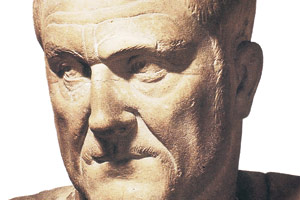Between the death of Domitian (96 A.D.) and the death of Marcus Aurelius (180 A.D.), Rome experienced the most prosperous period of its history. The empire reached its greatest extent under the government of Trajan (98-117) who extended Roman influence to the Persian Gulf by conquering Dacia, Arabia, Armenia and Mesopotamia. Trajan began great architectural projects in Rome, financed by the riches obtained during the conquest of Dacia (currently Romania).
The last emperor of the Flavians was Adrianus (117-138) whose greatest aim was obtaining peace. To do so, he ended the long struggle against the Parthians (Persians, in Asia), relinquishing control of Assyria, Mesopotamia and Armenia. He also concerned himself with the well being of the different provinces for this reason going on long voyages within the confines of the empire.
The Antonines and the Severans
The new Antonine dynasty began with Antonius Pius (138-161) who continued the peacemaking work of his predecessor and carried out a reform of the public service and the army. However, there were some frontier disputes during his reign, such as in Britannia, where a wall had to be built further north than Hadrian’s Wall (132 A.D.) There were also conflicts in Mauritania and Judea. On his death, he was succeeded by Marcus Aurelius (Adrianus’ nephew) and Lucius Verus (Adrianus’ adoptive son) who shared government. Officially, both had the same powers, but in practice, Marcus Aurelius held real power and Verus was given control of the army until 169, when he died.
Marcus Aurelius was constantly at war with a number of peoples on the edges of the empire, such as the Germans and the Parthians.
As of 176, Commodus became co-regent of the empire with his father, Marcus Aurelius. When the latter died, in 180, Commodus ascended to the throne as the sole emperor. His subjects took this well, because of their fond memories of the deceased emperor. Commodus, however, would soon prove a disappointment because of his megalomaniac and dissolute character (he had delusions of grandeur), and his despotical rule, where State affairs were left in the hands of his cronies. A conspiracy of his enemies led to his assassination in 192 A.D. Pertinax and then Didius Julianus, the last of the Antonine rulers, succeeded him in the space of one year (193), and both found death in the midst of various plots. In that very year Septimius Severus took the throne (193-211), re-establishing unity and beginning the Severan dynasty (193-235). The Emperors (some acting as co-emperors) of this lineage were (Septimius, Caracalla, Geta, Macrinus, Elagabalus and Alexander Severus.
Military Anarchy
The period following the death of Alexander Severus until the succession of Diocletian (235-284) was one of great confusion and is usually called the «Military Anarchy» or the «Military Empire«. It was characterized by the appointment of the Emperors by the Army, the separation of some areas from the empire and the impoverishment of the people and the State.
Of the twelve emperors (Maximinus Thrax, Gordian I, II, III, Philip «the Arab», Decius, Trebonianus Gallus, Valerian, Gallienus, Claudius II, Aurelian, Probus, Carinus Numerian) who governed in the first 33 years, almost all died violently. Among them, Claudius II and Aurelian stand out, the former for driving out the Goths, the later, for defeating the Germans and the Queen of Palmyra (now Syria), Septimia Zenobia, who had occupied Egypt and Asia Minor.
Aurelian was succeeded by a pair of relatively insignificant emperors (Probus and Carinus Numerian) until Diocletian’s ascension to the throne in the year 284.
The Low Empire: Crisis and Downfall
With Diocletian began what is known as the «Low Empire» which would last until the division of the Western Roman Empire.
Diocletian founded the period of the «Tetrarchy«, that is, government by four, which established a new division of powers and territorial organisation. the empire was divided into four regions governed by two Emperors, himself and Maximinus, and two Caesars, Constantius Chlorus and Galerius.
However when Diocletian abdicated (305), the tetrarchy went through various changes and in a short time the empire was reunited by a single ruler: Constantine. Constantine moved the imperial capital to Constantinople, consolidating the predominance of the East. He favoured the Christians by letting them practice their religion (Edict of Milan 313).
The following rulers had to face the constant threat of a barbarian invasion and the unmistakeable symptoms of the internal decadence of the empire.
Some time later the empire was once again divided when Theodosius (395) split it between his sons, giving the East to Arcadius and the West to Honorius.
Therefore, while Constantinople would remain the centre of the Eastern Empire and of the new Byzantine civilization for another millennium (until the Turkish invasion of 1453), the Western Empire met its downfall towards the end of the 5th Century when the Goths invaded Italy.








 Muere Evita
Muere Evita